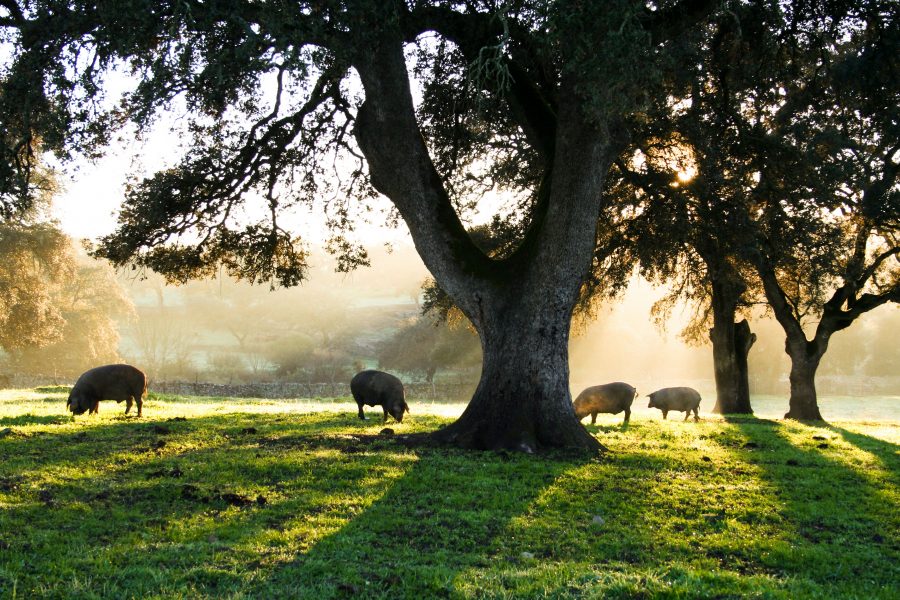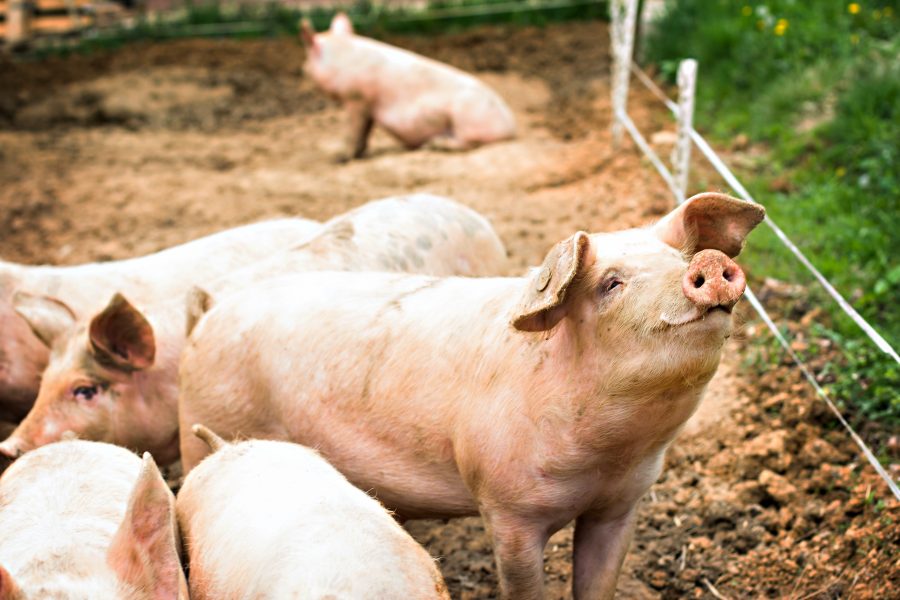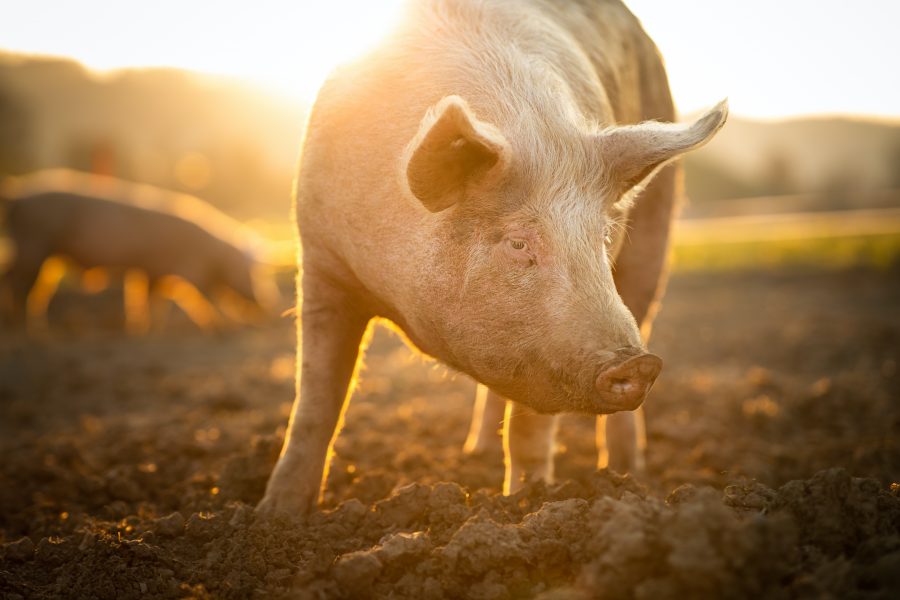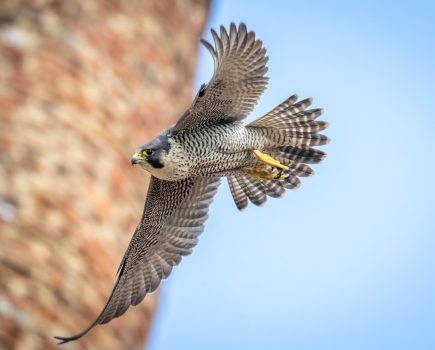Michaela Giles explains how pigs regulate their body temperature and the dangers that can arise when they’re unable to do so
Pigs are endotherms (warm-blooded), like all other mammals, meaning that they maintain their body
temperature through internal biological processes that produce heat.
In mammals, two separate homeostatic mechanisms are required to maintain a ‘thermoregulation
equilibrium’ – one increases body temperature, while the other decreases it, providing a high degree of
internal temperature control. This is important because the core temperature of mammals can be
controlled to be as close as possible to the optimum internal temperature for the essential enzyme
activities involved in all aspects of body function; from digestion through to movement. This makes the
animal relatively independent of the temperature of the environment.
Balancing act
If heat loss exceeds heat generation, metabolism increases to make up for the loss and/or the animal
shivers to raise its body temperature. If heat generation exceeds the heat loss, then mechanisms such
as panting or perspiring are triggered to increase heat loss. This means that endotherms can be active
and survive at quite low external temperatures but, because they must produce heat continuously, they
require adequate quantities of food to keep the whole process running.
A pig’s natural habitat would typically have been moist woodlands, swamps and shrublands, especially
oak forests and regions where reeds are abundant. They originated in cooler climates, and so evolved
with few sweat glands; these are only to be found in limited numbers on the snout, and on the lower
limbs. In practice, these are inadequate for use in cooling the body’s core temperature. So, to help
counteract this practical shortfall and assist the internal homeostatic processes, pigs employ specific
‘behavioural temperature regulation’.
Indoor, commercially-kept pigs have their conditions regulated to keep them at a comfortable
temperature for the most part, with climate-controlled barns maintained with fans and even water
sprinklers. Outdoor pigs, on the other hand, must be given a choice of surroundings that’ll enable them to
maintain their own ideal temperature – which changes depending upon the season. Throughout the year,
pigs will need somewhere warm to sleep without draughts, companions to sleep with, natural or artificial
shade, a wallow or shaded water and plenty of palatable water to drink.
Thermoregulation
Pigs lose heat in the form of ‘sensible’ and latent (evaporative) heat. Convection, conduction and
radiation are primary mechanisms by which sensible heat loss occurs, and each requires a temperature
difference between the warmer animal and its cooler environment. Therefore, as the environmental
temperature increases, animals redistribute blood towards the skin in an attempt to increase radiant heat
loss. With a further increase in temperature, reducing the difference in temperature between the pig and the
environment, the transfer of heat by conduction, convection and radiation modes decreases, eventually
leaving evaporation as the only route of heat loss.
Apart from having few functional sweat glands, a pig’s ability to regulate its temperature is further
complicated by a thick subcutaneous adipose tissue (fat) layer, which can impede sensible heat loss;
thus, pigs depend more on the respiratory route (ie, panting) for heat dissipation. But if their attempts at
increasing heat loss prove inadequate, then the animal will initiate a variety of behaviours to minimise
heat production and maximise heat loss, which include the following.
- Pigs eat less when they’re hot, to minimise internal metabolic processes generating heat. To
prevent loss of condition or reduced growth during periods of hot weather, it’s important to feed
early and/or late, when ambient temperatures are cooler. Research has shown that voluntary feed
intake is influenced by temperature, air speed and humidity. However, the reduction is dependant
upon genotype, diet composition, body weight and ambient temperature. Lower protein feeds
require less water intake etc. - Pigs will also move less when hot. All movement generates heat, which is what they’re trying to
avoid. - Hot pigs drink more to compensate for the additional water lost in cooling the body, so an
adequate supply of palatable water must be continuously provided if dangerous dehydration is to
be avoided. - They lose heat to the environment by convection, conduction and radiation, and by evaporation
through their respiratory tracts.

Trees or artificial barriers can minimise exposure to the direct heat of the sun.
Convection
This is the transfer of heat from an object to the air around it. In warmer conditions, pigs increase blood
flow by dilating their blood vessels (vasodilation) to body surfaces, which maximises heat transfer across
to the cooler conditions. Up to 35% of total heat loss is through convection, primarily through the skin
and ears, although heat transfer through the ears is not thought to be efficient, especially on some of the
hairier breeds.
To keep the core temperature warmer in colder conditions, the blood vessels constrict (vasoconstriction),
to minimise the amount of blood flowing close to the surface of the skin, thus preserving body heat. Heat
loss through convection can be a potential detriment during cold and mild weather, if wind speeds are too
high.
Conduction
This refers to the direct transfer of heat from one surface to another and, in pigs, accounts for 10-15% of
total heat loss. This heat transfer mechanism is why pigs can be seen scraping the topsoil of an area;
they’re attempting to expose the cooler soil beneath, before lying down on it. It’s also why the provision
of a wallow is so important, and explains why pigs urinate more in hot weather. This is an easy way of
dispelling large volumes of heat straight out of the body. Pigs use a form of conduction to keep warm in colder outside temperatures, known as kleptothermy. This process involves sharing or even stealing body warmth from ark mates.
Radiation
This is the transfer of heat from the pig to its surroundings without direct contact. For example, a hot pig
standing in a shady but breezy spot in the paddock can lose up to 30% of total heat loss in this way.
Evaporation
Evaporation is the process whereby a substance in a liquid state changes to a gaseous state, as the
result of an increase in temperature and/or pressure and, with pigs, it can account for 20-25% of total
heat loss. Because pigs don’t sweat to any great extent, most of this loss is through the respiratory tract,
via an increased respiration rate. A certain amount of evaporation also occurs when a wet pig leaves a
wallow or stream it had previously been using.
Heat stress
Heat stress occurs when the environmental temperature rises above the point where the pig is producing
more heat from digestion and/or receiving more heat from its surroundings than it is releasing to the
surrounding environment. The animal’s first reaction to this situation is that its blood vessels that run
close to the skin’s surface become enlarged, which increases blood flow and the skin’s surface
temperature. In turn, this increases the heat transfer rate to the environment.
Increased respiration serves to increase the water vapour output and, consequently, heat output and this
provides a clinical sign of heat stress. Other physiological responses such as skin temperature, rectal
temperature, tympanic (ear drum) temperature and vaginal temperature, can be measured.
The upper critical temperature is the point at which a pig’s internal core temperature becomes
dangerously high. The animal will be in ‘heat stress danger’, and will typically display increased
respiration (panting) and a loss of appetite. At best, this causes reduced growth in feeder pigs, or
reduced milk production in lactating sows and, at worst, the pig is at severe risk of dying if appropriate
measures are not taken.
Upper critical temperatures can easily be reached inside ventless vans without fans so, when
transporting young pigs home, or to shows, don’t travel for any distance during the hottest times of a
summer’s day – the pigs may well be dead by the time you reach your destination because, under these
conditions, evaporation will be their only method of heat loss.

Final thoughts
Cold water should NEVER be applied to a hot pig to cool it down, as this will cause the blood vessels to
vasoconstrict, triggering an increase in core temperature. The correct approach is to apply tepid water
frequently, preferably in a spray or mist. A good tip for those that exhibit pigs is to have sprayable water
readily available to help the pigs keep cool, and don’t wait until the animals have started to pant before
you start applying it.
When exhibiting pigs and returning from a show – especially on hot days – it’s a good idea to remove
any pig oil from the skin with a detergent and water. Any remaining oil on the skin will interfere with the
cooling process, until it wears off.
There’s emerging evidence suggesting that some of the leaner, modern pig breeds that have been
selected for their ideal production traits – lean meat, milk yield, fecundity etc – can exhibit reduced heat stress tolerance, because those breeding traits are associated with increased metabolic heat production.
So this perhaps ought to be a consideration when selecting pigs for outdoor production systems.
The provision of shade in the pig pen is an essential requirement. Trees or artificial barriers (such as
galvanised sheeting, shade cloths etc) can minimise exposure to the direct heat of the sun, and will also
reduce the surrounding surface temperatures. Practical design considerations for shade structures
include orientation, pitch, height and the material used in their construction.
Not providing pigs with the ability to regulate their own body temperatures can result in economic losses
associated with heat stress, shown by reduced and inconsistent growth, decreased feed efficiency,
decreased carcass quality (increased fat deposition and decreased muscle production), poor sow
performance, increased mortality (especially in sows and market hogs) and morbidity.
In addition, reduced reproductive performance can be characterised by anoestrus (failure to come into
season), increased wean-to-oestrus interval, decreased farrowing rate and reduced litter size. Similarly,
poor semen production and quality occur in boars exposed to heat stress, so it really is vital to ensure
that your pigs are able to control their body temperatures effectively.
This article was taken from The Country Smallholder. For more articles like this, subscribe here.








